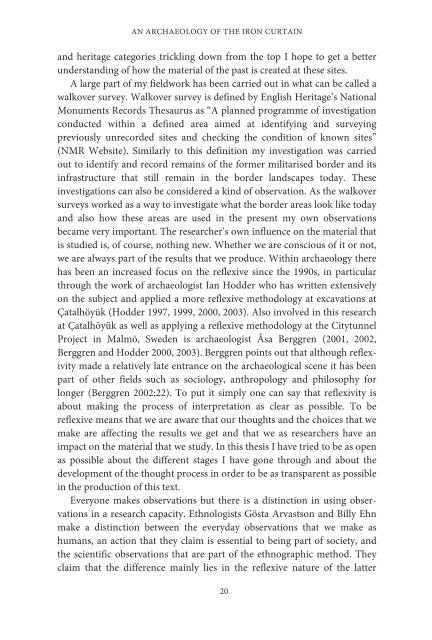1JZGauQ
1JZGauQ
1JZGauQ
Create successful ePaper yourself
Turn your PDF publications into a flip-book with our unique Google optimized e-Paper software.
AN ARCHAEOLOGY OF THE IRON CURTAIN<br />
and heritage categories trickling down from the top I hope to get a better<br />
understanding of how the material of the past is created at these sites.<br />
A large part of my fieldwork has been carried out in what can be called a<br />
walkover survey. Walkover survey is defined by English Heritage’s National<br />
Monuments Records Thesaurus as “A planned programme of investigation<br />
conducted within a defined area aimed at identifying and surveying<br />
previously unrecorded sites and checking the condition of known sites”<br />
(NMR Website). Similarly to this definition my investigation was carried<br />
out to identify and record remains of the former militarised border and its<br />
infrastructure that still remain in the border landscapes today. These<br />
investigations can also be considered a kind of observation. As the walkover<br />
surveys worked as a way to investigate what the border areas look like today<br />
and also how these areas are used in the present my own observations<br />
became very important. The researcher’s own influence on the material that<br />
is studied is, of course, nothing new. Whether we are conscious of it or not,<br />
we are always part of the results that we produce. Within archaeology there<br />
has been an increased focus on the reflexive since the 1990s, in particular<br />
through the work of archaeologist Ian Hodder who has written extensively<br />
on the subject and applied a more reflexive methodology at excavations at<br />
Çatalhöyük (Hodder 1997, 1999, 2000, 2003). Also involved in this research<br />
at Çatalhöyük as well as applying a reflexive methodology at the Citytunnel<br />
Project in Malmö, Sweden is archaeologist Åsa Berggren (2001, 2002,<br />
Berggren and Hodder 2000, 2003). Berggren points out that although reflexivity<br />
made a relatively late entrance on the archaeological scene it has been<br />
part of other fields such as sociology, anthropology and philosophy for<br />
longer (Berggren 2002:22). To put it simply one can say that reflexivity is<br />
about making the process of interpretation as clear as possible. To be<br />
reflexive means that we are aware that our thoughts and the choices that we<br />
make are affecting the results we get and that we as researchers have an<br />
impact on the material that we study. In this thesis I have tried to be as open<br />
as possible about the different stages I have gone through and about the<br />
development of the thought process in order to be as transparent as possible<br />
in the production of this text.<br />
Everyone makes observations but there is a distinction in using observations<br />
in a research capacity. Ethnologists Gösta Arvastson and Billy Ehn<br />
make a distinction between the everyday observations that we make as<br />
humans, an action that they claim is essential to being part of society, and<br />
the scientific observations that are part of the ethnographic method. They<br />
claim that the difference mainly lies in the reflexive nature of the latter<br />
20




